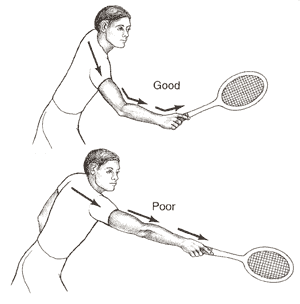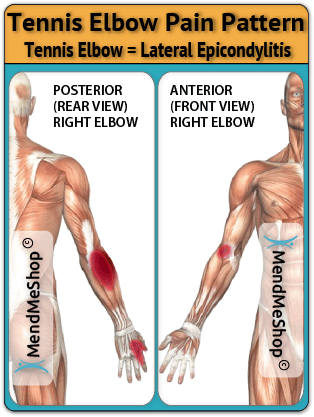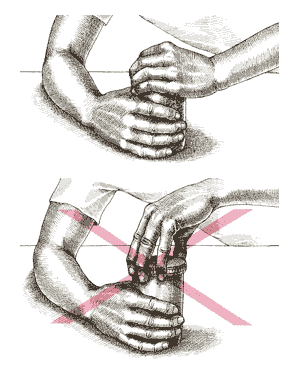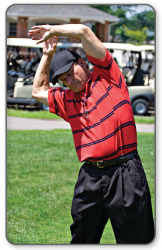If you play competitive sports, you know that there are added risks of incurring soft tissue injuries with intense physical activity. If you have a job that requires frequent repetitive biomechanic actions you will also soon discover that you can literally wear out certain tendons, muscles, cartilage or joints unless you take proper protective actions to prevent this - the most important one being rest.
It is always better to prevent tennis elbow rather than attempt to fix the injury after it has happened. There are a number of things you can do to keep your elbow, wrist and forearm healthy and prevent further damage.
You can reduce the risk of injury with a training program including warm-up, cool-down, and stretching exercises. Resistance training will help prepare your body for participation in physical activity.

Strengthening and stretching exercises will help to keep your arm strong and supple, which will reduce your risk of a soft tissue elbow, forearm or wrist injury. Also, a regular exercise program that focuses on total body fitness will keep you healthy overall. An important point often overlooked is to ensure that ALL the muscles and tendons are exercised and strengthened - this means you need to have multiple strength and stretching exercises so that less used (and generally weaker) tendons and muscles are also properly stretched and strengthened.
Learning the proper technique to achieve a specific task is extremely important when it comes to injury prevention. The usage of proper biomechanics help stabilize the elbow joint and preserve range of motion while reducing the risk of over-stressing specific muscles and tendons.
Avoid doing too much to soon to give your body an opportunity to build up its endurance, especially when starting a new activity. Gradually increase your participation to prevent overstraining your muscles. Remember to always warm up and cool down your forearm muscles before and after working them.

Learn and practice proper form and techniques to prevent injuries by utilizing your total body when possible, for example swinging a racquet with your whole arm rather than just your wrist. Keep your wrist in a neutral and/or slightly rigid position, and use your stronger upper arm muscles, rather than smaller forearm muscles when lifting or twisting. This is especially important when participating in something new such as a racquet sport, swimming, weightlifting, or throwing sports.
A number of ways to prevent tennis elbow (or any soft tissue) injury is through proper training, techniques, and equipment. Some helpful tips and techniques can include but are not limited to:

Choose the correct equipment for your body type. The size and weight of your equipment and tools definitely make a difference.
If you are suffering from wrist, elbow or forearm pain, decrease, modify and/or avoid any repetitive motions that cause irritation (usually twisting or gripping actions). If you are required to perform these motions at work or play and can not avoid them, make sure you take frequent breaks and rest your arm to prevent fatigue.
Avoid activities that exert excessive stress and strain on your wrist and/or forearm muscles

The best way to prevent an injury is to understand: (1) the risk factors of your activity, (2) how you can get an injury due to this activity, and (3) what role your environment plays in your health and well-being. Eliminate potential hazards where possible to reduce your risk of injury. Learn about the causes and symptoms of whatever specifc injury your activity places you at risk for - knowledge of the causes and signs of an injury can really help you identify problems earlier and reduce your risk of getting it in the first place.
Whether you play a sport, use repetitive movements of your arm during your favorite pass time, or have a physically demanding job, you should be able to identify potential risks. A set of steps to alleviate injury risk might be as follows:
Before engaging in any physical activity, you should do some light warm up exercises such as stretching and cardio. After your activity, gradually reduce your heart rate through cool-down exercise including stretching and yoga. Undergoing heat applications with the TShellz Wrap® - especially before activity/exercise - will increase elasticity in your tissue fibres and increase your range of motion (in the treatment area). This, in turn, will reduce your risk of re-injuring the area during activity; minimizing re-injury is key to an accelerated recovery!
Having a limited range of motion of your arm/elbow limits the overall performance of your body. Cross-training will help prepare your body for activity. Try something that doesn't rely on the same muscles you use for your main sport or activity. Swimming, running, cycling, yoga, and lower body resistance training can be very good for your overall health.

Self-management of weight is important to eat a healthy, well balanced diet and participate in regular activity, regardless of your fitness level. Speak to a nutritionist and physical therapist to develop a diet and exercise routine catered to your lifestyle and fitness goals.
Repetitive strain injuries, such as Tennis Elbow, result from chronic overuse. You need to rest and give yourself a chance to recover after physical activity to avoid injury. Conservative treatments such as cooling and heating treatments are not only used to treat injuries, but are also used in postoperative rehabilitation after surgery. In fact, the best way to prevent an injury is to consistently incorporate conservative treatments into your training routine.
While rest is important, good blood circulation is key to the health of your body. So, what to do if you need rest, but also want to maintain proper blood flow circulation? Circulation Boost provides the best preventative treatment for anyone who regularly uses repetitive and stressful movements involving the arms, shoulders, in fact, any part of your body!
Struggling To Heal And Cure Your Tennis Elbow? Click here to learn how to get rid of it fast.
Living with Tennis Elbow is never easy and we can help provide answers about prevention, causes, treatment options, potential stretches/exercise to consider, and ways to manage the condition for the short & long term.
Product Advisors are available 9:00 am to 5:00 pm Eastern Standard Time Monday to Friday.
I want to learn more about TShellz Wrap® Circulatory Boost
I want to learn more about Ice & Heat: Which Is Better For Treatment?
I want to learn How To Get Rid of Tennis Elbow
I want to learn How To Get Rid of Golfers Elbow
I want to learn more about Elbow Anatomy
I want to learn more about Elbow Surgery
I want to learn more about Elbow Post-Surgery Recovery
During your recovery, you will probably have to modify and/or eliminate any activities that cause pain or discomfort at the location of your soft tissue injury until the pain and inflammation settle. The more diligent you are with your treatment and rehabilitation, the faster you will see successful results!
Please be aware that this information is neither intended nor implied to be a substitute for professional medical advice. CALL YOUR HEALTHCARE PROVIDER IMMEDIATELY IF YOU THINK YOU MAY HAVE A MEDICAL EMERGENCY. Always seek the advice of your physician or other qualified health provider before using any of our outstanding products to make sure they are right for you and your condition or if you have any questions regarding a medical condition. Always see your doctor for a proper diagnosis as there are often many injuries and conditions (some very serious) that could be the cause of your pain.
© 2025 In.Genu Design Group, Inc. Contact Us